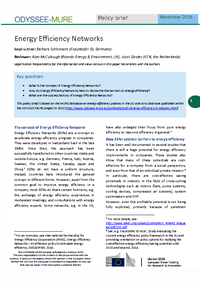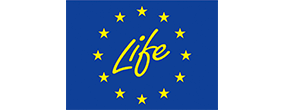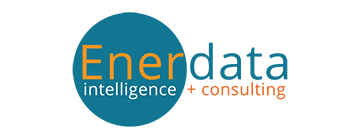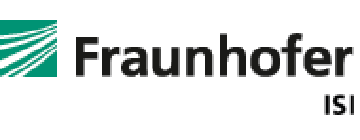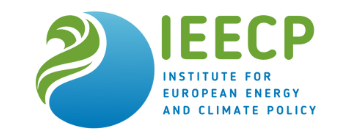Summary
Key questions
- What is the concept of Energy Efficiency Networks?
- How do Energy Efficiency Networks help to dismantle the barriers to energy efficiency?
- What are the success factors of Energy Efficiency Networks?
Key features of that brief were presented during a webinar (25 January 2017)
Lead authors: Barbara Schlomann (Fraunhofer ISI, Germany)
Reviewers: Alan McCullough (Ricardo Energy & Environment, UK), Joost Gerdes (ECN, the Netherlands)
The concept of Energy Efficiency Networks (EENs)
Energy Efficiency Networks (EENs) are a concept to accelerate energy efficiency progress in companies. They were developed in Switzerland back in the late 1980s. Since then, the approach has been successfully transferred to other countries inside and outside Europe, e.g. Germany, France, Italy, Austria, Sweden, the United States, Canada, Japan and China1. EENs do not have a uniform structure; instead, countries have introduced the general concept in different forms. However, apart from the common goal to improve energy efficiency in a company, most EENs do share certain functions, e.g. the exchange of energy efficiency experiences in moderated meetings, and consultations with energy efficiency experts. Some networks, e.g. in the UK, have also enlarged their focus from pure energy efficiency to resource efficiency in general2.
How EENs address barriers to energy efficiency
It has been well documented in several studies that there is still a huge potential for energy efficiency improvements in companies. These studies also show that many of these potentials are cost-effective for a company from a social perspective, and even from that of an individual private investor3. In particular, there are cost-effective saving potentials in industry in the field of cross-cutting technologies such as motors (fans, pump systems, cooling devices, compressed air systems), system optimisation and CHP.
However, even this profitable potential is not being fully exploited, primarily because of persistent barriers to the deployment of energy efficiency measures. Such barriers prevent companies from realising energy-saving potentials even though these are cost-effective under current economic conditions.
Important economic and non-economic barriers in industry include:
- Information and knowledge gaps with regard to both the existing saving potentials in the company and existing financial support programmes for investments in energy efficiency.
- Fear of the negative impact of energy efficiency measures on the quality of products and processes.
- Uncertain economic and legal frameworks and uncertainty in planning.
- Energy costs usually make up only a small share of total company operating costs. This means low priority for energy efficiency investments.
- Lack of sufficient own capital to undertake the necessary investments and unwillingness to use borrowed capital (especially in owner-operated companies).
- High transaction costs of investment in energy efficiency.
On the other hand, there are also driving forces that facilitate the implementation of energy efficiency measures in companies. For example, improving energy efficiency may be part of the company’s corporate image, or the company may already have an energy management system, internal efficiency benchmarking, or motivated employees with their own interest in energy efficiency.
Energy Efficiency Networks have several functions and provide services that are suitable to both remove these barriers and strengthen these driving forces. These include:
- Raising awareness of (cost-effective) energy-saving potentials by consulting energy efficiency experts.
- Regular meetings with the aim of capacity building within and between companies.
- Increasing transparency about energy use and data availability by implementing energy management systems or other benchmarking and monitoring tools.
- Providing information about private and public financing of energy efficiency investments.
- Making energy efficiency a higher investment priority.
In the following, the example of Germany is used to illustrate how EENs address the barriers to energy efficiency. There is now a 15 years experience with Energy Efficiency Networks in this country, and recent strong support for the establishment of new EENs.
Energy Efficiency Networks – the German case
History of EENs in Germany
EENs were first established in Germany in 2002. In 2008, a consortium of research institutes and companies initiated a “30 Pilot Networks” project funded by the German government. The goal of this pilot project was to demonstrate the benefits of EENs and to establish a management system - the Learning Energy Efficiency Networks system (LEEN) - for their operation at high standards. In 2014, the project was extended to 100 EENs, all operated using the LEEN standard. In December 2014, the National Action Plan on Energy Efficiency (NAPE) was published by the German federal government4. This plan adopts and further extends the idea of Energy Efficiency Networks by setting a target of 500 operational networks in 2020. However, the standards set for these networks are lower than the standards in the LEEN pilot project. By mid 2016, 75 new EENs had been established under the “500 Energy Efficiency Networks Initiative”5.
Functioning of a LEEN Network
How LEEN Networks function and their results are well documented in the literature6.
The usual network process consists of three phases (Figure 1). The initiation phase (Phase 0) establishes the network. Usually, 10-15 companies operating in different sectors are recruited by the network operator (e.g. a utility, industrial association or platform, Chamber of Commerce and Industry, city government, or consulting engineer) to form a LEEN. LEEN addresses medium-sized and large companies with yearly energy costs between 0.5 and 50 million euros.
The actual network process begins with an energy review phase 1. The companies fill in a data form concerning their energy situation and the certified consultant engineer carries out an energy audit. Based on this, the participants decide individually on their own efficiency target (confidential) and also commit themselves to a voluntary energy saving target of the whole network and to the regular exchange of experiences in their network for at least the next 3 – 4 years.
The targets set in phase 1 are to be reached in the network operating phase 2. Core elements of phase 2 are site inspections and the moderated network meetings held three to four times per year. These meetings integrate the capabilities and skills of invited experts and participants as well as encouraging the exchange of experiences. These exchanges may focus on the implementation of saving measures for common technologies such as compressed air systems, but also on organizational measures like awareness raising among employees. Another important topic is the financing of energy efficiency investments, e.g. how to access financial support in the form of subsidies, loans or aid. The participants also report on the implemented measures (e.g. difficulties and achievements, and experiences with contractors). These points are particularly valuable for the participating companies, since the information provided is objective, because the speakers are not trying to sell anything and the results are from real applications presented by unbiased peers. All these activities in the network operation phase help to reduce both the economic and non-economic barriers to energy efficiency in companies.
Continuous monitoring of the implemented measures by the companies makes it possible to track the progress made in improving energy efficiency and reducing energy-related greenhouse gas emissions in the company and the entire network. This monitoring is assessed once a year by the consultant engineer. In order to guarantee an overall performance standard, the LEEN network management system provides various tools such as a data collection form, software-based techno-economic calculation tools, sample reports including a measure overview, and minimum requirements with respect to the energy review report. The LEEN standard is not an official standard approved by a standardization organization. It is a voluntary quality standard for establishing and running EENs.
Figure 1: Stages of a LEEN network
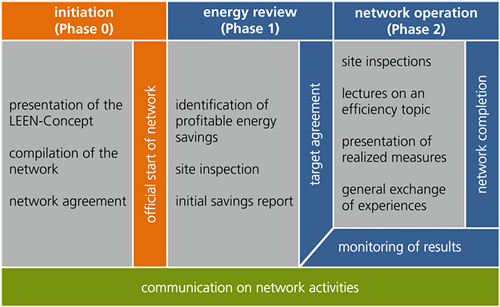
Success of LEEN Networks
There was a comprehensive evaluation of the 30 pilot networks. Selected key results are presented below.
A major share of the identified measures addresses electrical cross-cutting technologies. More than 30 % of the measures deal with process heat and space heating. Energy carrier changes resulting in reduced energy demand or reduced CO2 emissions represent only a smaller number of the measures. The average payback time for the profitable measures is between 2.2 years for compressed air systems and 4.3 years for air conditioning. However, not all of the measures are simple and cheap “low- hanging fruit”. Some require a notable investment. The majority (~85 %) of the identified measures requires investments below € 50,000, but 17 % require an investment above € 50,000.
The quantitative monitoring performed jointly by the energy manager and the consulting engineer reveals that the annual efficiency improvement of the participants was 2.1% per year on average. In absolute terms, this resulted in energy savings of about 5 PJ per year after the 4 year duration of the 30 pilot networks.
As part of the evaluation, the participating companies were also asked about their experiences with the networks. There were positive reports for the concept of EENs. The majority of participants (over 90%) stated that they accomplished the energy efficiency measures recommended during the network operation phase. 75% reported that some of those measures would not have been implemented without the networks. Additionally, about 75% of the participants rated the benefits of network participation as “rather high” or “very high”. Over 60% indicated that the contacts made within the network were used beyond the network meetings.
Other types of Energy Efficiency Networks
Apart from the classical LEEN Network (http://leen.de/en/leen-netzwerke/) for larger industrial companies, other Energy Efficiency Network initiatives have been established in Germany over the last few years, which illustrate the large variety of the EEN concept:
- The “500 Energy Efficiency Networks Initiative” of the German government shows a greater spread in the size of the participating companies and in the number of companies in a network compared to the LEEN networks.
- Networks for small and medium-sized companies with energy costs between €30,000 and €500,000 per year with a less demanding energy management system.
- Some branch-specific networks in industries or company groups that do not compete in terms of energy costs (e.g. hotels and restaurants).
- Corporation-internal networks where several production sites of one corporation work together in one network.
- Municipal Energy Efficiency Networks for cities with up to 200,000 inhabitants or networks for the corresponding counties/districts.
Success factors of Energy Efficiency Networks
Based on the experiences in Switzerland, Germany and other countries, some general factors can be derived that drive the success of EENs7:
- The development of a network structure that provides all the services required to remove the different economic and non-economic barriers.
- The provision of tools and standardised guidelines to lower implementation and transaction costs and ensure a high quality of energy savings (e.g. the LEEN standard).
- The specification of a clear time frame for the network.
- Providing training for those operating the network (managers, moderators, consultants) and for the staff in the participating companies.
- Developing a sustainable business model for EENs that reduces dependency on government support.
Conclusions and outlook
As the experience with longer running EENs shows, this concept can make a significant contribution to improving energy efficiency in companies. New network initiatives can build on the success factors derived from previous ones. EENs not only contribute to reducing energy consumption and energy costs, they also contribute to climate protection and provide opportunities for domestic manufacturers and installation firms. The network approach can help to reduce the burden on the energy infrastructure, while at the same time minimizing the dependence on energy imports. These are the reasons why the idea of EENs has already spread from its pioneers in Switzerland and Germany to several other countries. Worldwide dissemination of the concept of EENs including some basic requirements to ensure the success of the instrument is a conceivable and desirable goal for the near future.
Notes
- 1: For an overview, see International Partnership for Energy Efficiency Cooperation (IPEEC), Energy Efficiency Networks – An effective policy to stimulate energy efficiency, OECD/IPEEC 2016.
- 2: For more details, see: http://www.ipeec.org/upload/publication_related_language/pdf/155.pdf
- 3: See, e.g. Fraunhofer ISI et al., Study evaluating the current energy efficiency policy framework in the EU and providing orientation on policy options for realising the cost-effective energy-efficiency/saving potential until 2020 and beyond, 2014.
- 4: http://www.bmwi.de/EN/Topics/Energy/Energy-Efficiency/nape,did=667778.html
- 5: For more information, see: https://www.measures.odyssee-mure.eu/energy-efficiency-database/#/measures/1157
- 6: See, e.g. Rohde et al., Learning Energy Efficiency Networks - Evidence based experiences from Germany, ACEEE Summer Study 2015 Proceedings.
- 7: This compilation is based on IPEEC, Energy Efficiency Networks – An effective policy to stimulate energy efficiency, OECD/IPEEC 2016, pp. 30-31.
